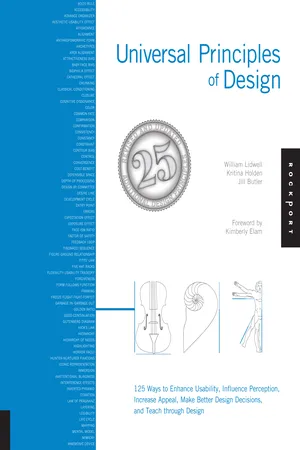
Universal Principles of Design, Revised and Updated
125 Ways to Enhance Usability, Influence Perception, Increase Appeal, Make Better Design Decisions, and Teach through Design
- 272 pages
- English
- ePUB (mobile friendly)
- Available on iOS & Android
Universal Principles of Design, Revised and Updated
125 Ways to Enhance Usability, Influence Perception, Increase Appeal, Make Better Design Decisions, and Teach through Design
About this book
Universal Principles of Design, Revised and Updated is a comprehensive, cross-disciplinary encyclopedia covering 125 laws, guidelines, human biases, and general considerations important to successful design. Richly illustrated and easy to navigate, it pairs clear explanations of every design concept with visual examples of the ideas applied in practice. From the 80/20 Rule to the Weakest Link, every major design concept is defined and illustrated.
Whether a marketing campaign or a museum exhibit, a video game or a complex control system, the design we see is the culmination of many concepts and practices brought together from a variety of disciplines. Because no one can be an expert on everything, designers have always had to scramble to find the information and know-how required to make a design work—until now.
Just a few of the principles that will broaden your design knowledge, promote brainstorming, and help you check the quality of your work:
- Baby-Face Bias
- Expectation Effect
- Golden Ration
- Ockham's Razor
- Proximity
- Scaling Fallacy
The book is organized alphabetically so that principles can be easily and quickly referenced by name. For those interested in addressing a specific problem of design, the principles havealso been indexed by questions commonly confronting designers (How can I help people learn from my design? How can I enhance the usability of a design? How can I make better design decisions? ...).
Each principle is presented in a two-page format. The first page contains a succinct definition, a full description of the principle, examples of its use, and guidelines for use. Side notes are included, and provide elaborations and references. The second page contains visual examples and related graphics to support a deeper understanding of the principle.
This landmark reference is the standard for designers, engineers, architects, and students who seek to broaden and improve their design expertise.
Frequently asked questions
- Essential is ideal for learners and professionals who enjoy exploring a wide range of subjects. Access the Essential Library with 800,000+ trusted titles and best-sellers across business, personal growth, and the humanities. Includes unlimited reading time and Standard Read Aloud voice.
- Complete: Perfect for advanced learners and researchers needing full, unrestricted access. Unlock 1.4M+ books across hundreds of subjects, including academic and specialized titles. The Complete Plan also includes advanced features like Premium Read Aloud and Research Assistant.
Please note we cannot support devices running on iOS 13 and Android 7 or earlier. Learn more about using the app.
Information
Table of contents
- Cover
- Title page
- Dedication
- Contents: Alphabetical
- Contents: Categorical
- Foreword
- Introduction
- 80/20 Rule
- Accessibility
- Advance Organizer
- Aesthetic-Usability Effect
- Affordance
- Alignment
- Anthropomorphic Form
- Archetypes
- Area Alignment
- Attractiveness Bias
- Baby-Face Bias
- Biophilia Effect
- Cathedral Effect
- Chunking
- Classical Conditioning
- Closure
- Cognitive Dissonance
- Color
- Common Fate
- Comparison
- Confirmation
- Consistency
- Constancy
- Constraint
- Contour Bias
- Control
- Convergence
- Cost-Benefit
- Defensible Space
- Depth of Processing
- Design by Committee
- Desire Line
- Development Cycle
- Entry Point
- Errors
- Expectation Effect
- Exposure Effect
- Face-ism Ratio
- Factor of Safety
- Feedback Loop
- Fibonacci Sequence
- Figure-Ground Relationship
- Fitts’ Law
- Five Hat Racks
- Flexibility-Usability Tradeoff
- Forgiveness
- Form Follows Function
- Framing
- Freeze-Flight-Fight-Forfeit
- Garbage In–Garbage Out
- Golden Ratio
- Good Continuation
- Gutenberg Diagram
- Hick’s Law
- Hierarchy
- Hierarchy of Needs
- Highlighting
- Horror Vacui
- Hunter-Nurturer Fixations
- Iconic Representation
- Immersion
- Inattentional Blindness
- Interference Effects
- Inverted Pyramid
- Iteration
- Law of Prägnanz
- Layering
- Legibility
- Life Cycle
- Mapping
- Mental Model
- Mimicry
- Mnemonic Device
- Modularity
- Most Advanced Yet Acceptable
- Most Average Facial Appearance Effect
- Normal Distribution
- Not Invented Here
- Nudge
- Ockham’s Razor
- Operant Conditioning
- Orientation Sensitivity
- Performance Load
- Performance Versus Preference
- Personas
- Picture Superiority Effect
- Priming
- Progressive Disclosure
- Propositional Density
- Prospect-Refuge
- Prototyping
- Proximity
- Readability
- Recognition Over Recall
- Red Effect
- Redundancy
- Rosetta Stone
- Rule of Thirds
- Satisficing
- Savanna Preference
- Scaling Fallacy
- Scarcity
- Self-Similarity
- Serial Position Effects
- Shaping
- Signal-to-Noise Ratio
- Similarity
- Stickiness
- Storytelling
- Structural Forms
- Symmetry
- Threat Detection
- Three-Dimensional Projection
- Top-Down Lighting Bias
- Uncanny Valley
- Uncertainty Principle
- Uniform Connectedness
- Veblen Effect
- Visibility
- Visuospatial Resonance
- von Restorff Effect
- Wabi-Sabi
- Waist-to-Hip Ratio
- Wayfinding
- Weakest Link
- Credits
- Acknowledgments
- About the Authors
- Index
- Copyright Page